American Sabbatical 78: 3/26/97
West Palm Beach
3/26.. West Palm Beach
The Owl crew arose rejuvenated Tuesday morning in DeLeon Springs, had a last gulp of the local
waters, and set off in search of history. Personal history. Today’s
retrospection was focused on some old friends. Dick, Jane, and
Spot.
The Orlando Public Library is presenting an exhibit on the Dick
and Jane books, and we aimed the red bird at Disneyland East for
a reunion. This is another boom country centered on grand illusions.
Go to the movies, revisit them at Disney World, then move to Orlando.
Orlando restores your faith in fiction. This is the Florida of
John D MacDonald and Ken Haaisen. The one we imagined. Swamps
paved over to make a greater New Jersey. To get us in the mood
we slotted into a rush hour jam inching into the city.
When we got there, downtown was surprisingly attractive and low
key, and the library quite impressive. After our abortive book
searches in the low country South, I didn’t expect Floridians
to be able to read. I mean, Dick and Jane seemed about right.
Granted there was an immense amount of space in the soaring Sixties
Cement Style mausoleum, and the stacks seemed beside the point.
This was about reverence for books, not access to vast collections.
Still it was comforting to be welcomed into an integrated literary
spa down here.
I’ll let Peggy describe the exhibit, which was a bit thin to my
eye. We both had cut our milkteeth on Dick and Jane, but I didn’t
get a nostalgic twinge looking at the period watercolor images,
or reading aloud, “See Dick run. Run, Dick, run.” Not gaga enough
for a geezer license yet, I guess. (They should issue special
G plates for the erratic elders on the road down here. Sheldon
patiently waited through a light behind a dozing granny in a Cadillac
on Sunday, just one of those driving obstacles in FLA.)
(Memo #71)
March 26 Dick & Jane in Orlando
Who? Dick, Jane, Sally, Spot, Mother, Father
What? Scott, Foreman basic readers
Where? Orlando Public Library
When? now
How? traveling library exhibit
Topics: reading, basic readers, phonics v. whole language, culture
change, gender roles, stereotyping, Women’s Liberation Movement,
educational psychology
Questions: What images do children get through their very first
books? How do basic readers change over time to reflect/express
cultural changes? How did the Women’s Movement affect books? |
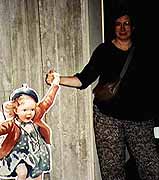
See Peggy and Jane
|
Orlando, Florida, is Disney cartoon characters, resort hotels,
and amusement park rides; it is also the site of a super public
library. When we saw an ad for an exhibit on “The Story of Dick
and Jane” at the library, we had to go and see this other Orlando.
Downtown Orlando is full of open spaces, grassy squares, pedestrian
malls, and modern buildings. The library (Florida’s biggest) is
a white building built in 1960’s cement modern. It has glass walls,
open reading areas, skylit staircases, meeting rooms, and its
own cafe(!). The library has a wide range of activities from lecture
to storytelling (it has its own FULL TIME staff storyteller!).
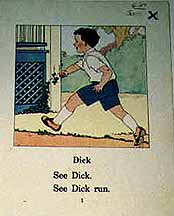
|
The Dick and Jane exhibit was nicely displayed, a decade to a
floor - i.e. there were hanging panels reproducing pages from
the books with explanatory text with the 1930’s on one floor of
the library, 1940’s on another, 1950’s another, 1960’s another.
There were life size cutout models of Dick and Jane at the beginning.
I learned to read on the Dick and Jane books, they are icons of
Americana and they were among the first book images my generation
got. (Would the pictures dredge up early memories for me the way
“Blueberries for Sal” or “Mike Mulligan’s Steam Shovel” always
do???) The first line “See Dick Run” has been endlessly quoted
and readapted. |
In the 1960’s and 1970’s the books were attacked as sexist and
hopelessly middle class. Dick and Jane inhabited a safe, happy,
suburban home with mother in the home cooking and cleaning and
father at work. Everything was clean and neat. And WASP. Pickets
fences and large yards. Everyone was happy.
Whose reality was being portrayed here?, critics asked. Where
were the people of color? The blended homes? The different families?
The working mother? The dysfunctions of America? What tasks were
being portrayed for girls and for boys? Were these books pushing
traditional sex roles? I remembered the controversy and was eager
to revisit the books. |
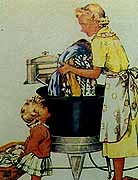
Mother's Work
|
The first thing that hit me were the muted colors, the illustrations
were in soft and somewhat muddy pastels, easy on the eyes, not
the vibrant crayon colors of today’s kids’ books. Our visual universe
has radically changed - these books were published, after all,
before TV, VCRs, camcorders. We have different visual habits in
different decades. As I toured, I felt a sense of familiarity
but no shock of recognition.
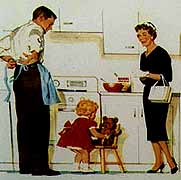
Changing Roles
|
The Dick and Jane books were the brainchild of Zerna Sharp at
Scott, Foreman who edited this “look-say” reader series call pre
primers. There were different writers over the years. The books
used simple words (look, see, go, run) and they were repeated
many times. There was a formula. “See Dick. See Dick run.” one
first page read, with an accompanying illustration of Dick running.
The next page said “See Jane. See Jane run. Run, Jane, run.”
|
| This basic reader series was to be an alternative to phonics (teaching
reading by having kids learn to recognize sounds in specific letters
and then combining sounds). Today the discussion over reading
uses the terms “whole language” and “phonics” and “reading readiness”
and many more that elementary teachers know. Ideas about how and
when and what kids can and should learn to read change over time.
Educational psychology, developmental psychology, and education
are distinct academic fields that test reading theories and help
in the development of new reading materials. It would be interesting
to know the theoretical discussions that produced Dick and Jane
and to find out how radical the books were in their time. The
exhibit did not cover this or quote articles or book reviews. |
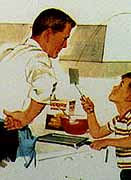
Men's Work
|
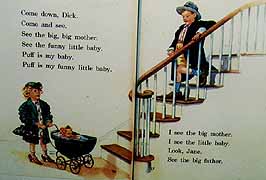
Playing House
|
The 1940’s books had Dick, Jane, Baby, Mother, Father. The incidents
are nearly all focused on the yard (with several big trees) where
Dick and Jane run and play or in their house. A very few are in
stores and a very few in public places or in cars. Into the 1940’s
and 1950’s Mother peels apples, makes candy, does laundry (in
a wonderfully anachronistic fill-up-by-hand wringer washer), knits,
vacuums, launders, shops, sews, washes dishes, serves food and
eats. Father shows the kids things, drives, eats (and is much
less present). The girls and Mother all wear skirts ( the hemlines
vary and the girls’ go DOWN over time), and Mother wears a nice
dress and an apron as she works. |
In the 1930’s the boys wear shorts, in later decades long pants.
Father wears a hat with his office suit, a short sleeved shirt
and slacks when he’s at home. Hair is neatly cut, mother’s hair
looks curled. In each book Teddy Bear has an accident and is rescued.
Grandmother and Grandfather are just leaving in their car after
one visit.
In the 1960’s books the sex roles have been consciously changed.
Father dons an apron and does dishes now too! And Mother drives
a car! In one playful illustration Father pushes Mother in a children’s
wagon (adults can have fun too). Mother is shown on her own with
the kids outside the home. There are many children of color playing
with Dick, Jane, and Sally. The editors tried to appease the critics.
A “multi-ethnic” reader was published in 1965. The basic “look-say”
formula was the same. The setting and social class seem to the
same. It is still happy, middleclass families. The changes seem
to have made little difference; the Dick and Jane series disappeared.
| The exhibit did not give many facts about the demise of the series
(did Scott Foreman simply opt out? Were there lawsuits? Opposition
by organized groups? NOW?). Could the series have used the changes
of the women’s movement? Could Dick and Jane look at Mother leaving
for work? Could Dad launder? Or would it seem contrived? What
new series have been produced that expertly express the reality
of America? Is there a really modern Dick and Jane. |
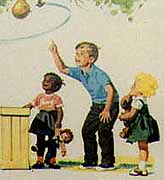
Changing Stereotypes
|
How successful were these books? By 1960, 85% of American schools
were using them and many homes as well.The images were central
to the development of American children for three decades. How
deep did the influence go? Did kids in fact internalize the expectations
that families were happy and always had two parents, that people
had lovely houses and yards and life was safe? Are their struggles
of the Baby Boomers partly the struggle of making Dick and Jane
fit reality?
3/26.. cont.
The Orlando Public has a bookstore, and a cafe (serving organic specials), in addition
to public internet access in spades. Although a picketer out front
angrily accused them of dealing seconds. I invited his harangue.
Tall and skinny with an emaciated face, the protester claimed
to be a homeless cybernaut, who uses the library as his e-mail
and web access. He calls it his “home.” He has created personal
web sites using their facilities and has subscribed to e-mail
and web services through their in-house software. He circulates
his resume to electronic employers this way. Now, he says, the
library is censoring his mail, and denying him access to his subscribed
services.
He contends that the systems managers are now scanning all internet
communications through their system using proprietary software
(he mentioned “Web Censor” as one program). They’ve publicly stated
that this is to protect children in the library from accessing
pornography, but this protester says you can still walk in and
download porn (he had an example on an homemade poster.. blackened
out in the appropriate places). But they’re reading everyone’s
mail, and censoring it. In his angular excitement he shouted,
“They’re denying me the right of free speech!” The ACLU is considering
prosecution, he says. Big Brother is watching you in Orlando.
The library is a block from one of Central Florida’s omnipresent
lakes, and we skirted it, to discover ourselves in a quiet, lush
green, suburbia.. within walking distance of highrises downtown.
As so often happens to others in America, we got lost in the burbs.
Finally gave up and cranked it up onto the Florida Turnpike. Big
mistake: exits 50 miles apart, and $5 per.
Could be central Illinois, but with palm trees. Feedlots to the
far horizons, and an unforgiving sun. We detrained the semi express
at Yeehaw, and slipped into the sleaze. Roadside attractions disguised
as information facilities. Hang onto your wallet. Southern drawl
is giving way to Brooklynese.
The backroad to Okechobee runs between the agribiz, and the Lake
itself is a lowrent resort for the entire midsecton of the US.
Surrounded with RV camps ($10 a night and up), and trailer parks,
parking lots full of pickups and other old iron wearing Kentucky
and Tennessee and Ohio and Indiana plates, and every vehicle sporting
a loaded boat trailer with a humongus mill on the stern.
We did bag-lunch (hot fresh tomatoes) in a marina rec area lot
under exotic shade trees half-smothered in strange epiphytes.
Going to need a field guide, if we’re going to make any sense
at all of the veg here. Lake Okechobee itself is completely surrounded
by looming dikes intersected every few miles by control gates
and canals. We drove to the top of the levee to see the heat shimmer
dissolving into infinity across the big lake. Everything from
pontoon party platforms to blast-off bass boats were churning
the pale waters, but the total exposure to a blistering sun sent
us scuttling.
West Palm Beach was our destination resort. Thought we’d drop
in on the Kennedys. Introduce the Owl to some chic company. And
it was there all right, poshing up the porte-cocheres. Jags, Bentleys,
and mere Mercedes and BMWs, glittering in their pride under exotic
plantings in the chateau courtyards. Chateau is big in West Palm,
as is Villa, and everything else large and European. Of course
there’s been some cross-breeding. This IS the land of the free.
So there are faux-marble Italianate Baronials with Spanish tile
roofs and gewgaws, Romanesque stucco and wrought with Moorish
detailing, Parisiene hauteur and plain old Yankee brass.
And the plantings! I’d thought Southern California affluence made
for the most elaborate landscape gardening, but I was wrong. There
the arid economy demands a certain floral aloofness, a rationing
of habitat, with spiky desert things maintaining their isolate
expressions. The Californos may be extravagant with the H2O, but
the atmosphere has the last say. In this humid place anything
goes, and grows rank, intertwining and exuding verdance. On this
sand spit where the money goes, the side streets are lined with
exotica, different species for each street , as in Beverly Hills,
but you feel you might need a machete to go visiting.
| We parked to Owl close to a Spider convertible, for a little excitement,
under one of a row of sand pines.. a new one on me, with thick
drooping brushes of needles in a sallow blue-green hue. At the
beachend corner of the block, coconut palms leaned out and shimmied
in the hot breeze, their green fruit hanging overhead. The high
walls alongside us, holding all the money in, were drowned in
ivy, or ivy-like vines, and little lizards scampered in an out
from under their leaves. Froze in curious attitudes at our feet,
like comic dancers, then scooted for cover when we moved. |

West Palm Look
|
We brazened the beach with our swim togs under our arms, and surreptitiously
changed in the shade of the overhanging greenery. Nobody was in
the water and no guards in sight. Of course we couldn’t really
get away with pretending we belonged here. We just couldn’t bring
ourselves to wear all our gold jewelry into the brine. A modest
surf was running, and we flung ourselves into it with abandon.
If we have to be sucked out to sea in a vicious undertow, so be
it. O SO be it.
Maybe you should wait until you’re 50 to experience tropical salt,
or until you’ve been very good. How can you explain the tepid
luxuriance of it to a Mainer still up to his waist in sneat? Maybe
you can tell them one day they may deserve it. Chin up. PipPip.
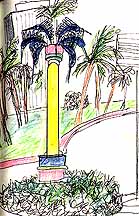
Peggy's West Palm
|
Thoroughly superior now, we yanked the Owl away from his new companion,
before they started rubbing fenders, and cruised up and down the
gold coast. It answers the question how to spend your spare millions
graciously, but I’d get a little itchy watching the black menials
in uniforms lining up at the bus stops, and wonder what they thought
about my new limo. Although the most beautiful banyan tree in
town shaded a bench at the curbside where an elderly gardener
waited for his bus.
|
We had come to West Palm because a college classmate of Peggy’s
has a play running here at the Burt Reynolds Institute of Theater
Training (BRITT), the local performance center. Stephen Mo Hanan
was the director of plays and musicals Peggy performed in back
then, and he went on to a career on Broadway (in CATS, etc.).
In the 70s he wrote a play based on the Bible stories about King
David, DAVID DANCES, and now it's premiering at BRITT.
BRITT anchors a downtown section of West Palm, otherwise distinguished
by the overpowering new courthouse (have you noticed how judicial
architecture is having a renaissance, along with new jails?),
the public library, and highrise parking lots. We needed to argue
with the box office about tickets (they were refusing to refund
us for two we’d gotten for friends who couldn’t make it.. a sure
sign of a theater in trouble, when they quibble about refunds),
so we were hours early, and chose to cruise the local secondhand
store (dresses from $60), and eat at the adjacent restaurant.
|
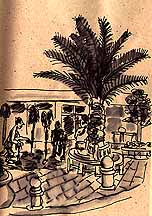
Fountains
|
The theater and eatery look out onto a brickpaved square in front
of the library, where maybe a dozen fountains play vertically
in random patterns. These gushing, those spraying eight feet high,
others turned off, in rapid changing sequences. The fountain yard
was full of children, of all hues, running, splashing, and yowling
with delight as the squirts blasted them. A warm southerly blew
in off the waterway, and we did a lizard thing over spinach ravioli,
uncurling in the echoed childsplay. Homeless men in lived-in clothes
worked the cafe tables for handouts, and slept on the park benches.
The play, in a magnificent new theater, was very much about the
70s.. at least between the lines. The story tells of a time of
paradigm shift, when a charismatic poet-warrior (David) is anointed
to replace a power-hungry despot (Saul) by an ecstatic seer (Samuel).
Steve says it was written when McGovern was running against Nixon.
(Steve had come to the show, and we joined him at intermission.)
Saul is a pistol-packing paranoid, while David sings transcendent
psalms to his autoharp, and the Philistines carry Uzis. The music
is quite moving, and the acting superb, but the suspension of
disbelief which theater creates was jarred awake too often by
the contemporary asides. Too many anachronisms broke the spell.
Just like the 70s. We were trying to change everything all at
once, and fell between the paradigms. David has an implicit homosexual
relationship with Jonathan (Saul’s son), and his many women lovers
are alluded to. He is energized by the ecstatic holiness of the
prophet Samuel, but the proto-Christian love ethic he preaches
is belied by the violence of his ascension. The goddess-god David
invokes is too much a contemporary truth, and jars in the context.
Steve warned us that the second half of the play was very dark,
but how could it be otherwise? Our idolized charismatics were
gunned down, and the only archetypal hero to ascend to our throne
was the Teflon Man, a genial grandfather who told us to do whatever
we wanted to. (Just SAY no.) Moving scenes, but it leaves you
muddled. If we were transported, it was to the disillusionment
of the Nixon years. The hazards of being too true to life.
It felt like a bit of New York night life, and we went out into
the muggy darkness wondering about the convolutions of time and
place that brought this play to the surface in West Palm now,
and us to the BRITT to see it. We propped our eyelids open and
drove an hour south to our reserved room in Fort Lauderdale.









